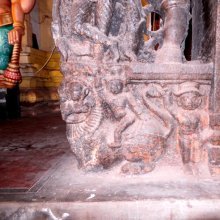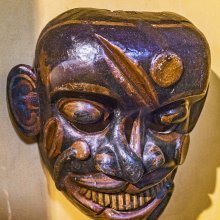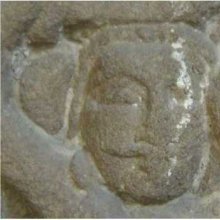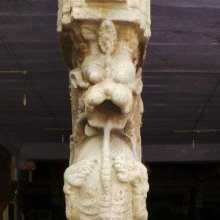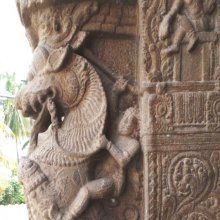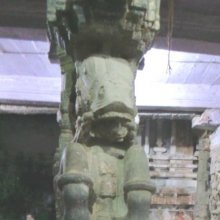Soldier: 2 definitions
Introduction:
Soldier means something in Hinduism, Sanskrit, the history of ancient India. If you want to know the exact meaning, history, etymology or English translation of this term then check out the descriptions on this page. Add your comment or reference to a book if you want to contribute to this summary article.
Images (photo gallery)
(+24 more images available)
In Hinduism
Shilpashastra (iconography)
Source: Shodhganga: Elements of Art and Architecture in the Trtiyakhanda of the Visnudharmottarapurana (shilpa)Soldiers or Warriors refers to a certain class of personalities which follows specific guidelines in the tradition of ancient Indian Painting (citra), according to the Viṣṇudharmottarapurāṇa, an ancient Sanskrit text which (being encyclopedic in nature) deals with a variety of cultural topics such as arts, architecture, music, grammar and astronomy.—The pictures of warriors should express the feeling of heroism. That is why the face of a soldier is instructed as to be painted with frowns and the face should have powerful and arrogant look. Thus the Viṣṇudharmottarapurāṇa establishes the fact that even in the pictures; the people belonging to different class and profession [e.g., soldier] were projected with specific attire so that general people can equate the picture with the practical character. The dress of soldiers accordingly should be quite short and the expert archers should be dressed up in such a way that it reveals their thighs.

Shilpashastra (शिल्पशास्त्र, śilpaśāstra) represents the ancient Indian science (shastra) of creative arts (shilpa) such as sculpture, iconography and painting. Closely related to Vastushastra (architecture), they often share the same literature.
India history and geography
Source: Singhi Jain Series: Ratnaprabha-suri’s Kuvalayamala-katha (history)Soldiers (fighting with weapons on the battle-field) were commonly depicted on the Saṃsāracakra paintings (representing scenes of human life), in ancient India, as mentioned in the Kathās (narrative poems) such as Uddyotanasūri in his 8th-century Kuvalayamālā (a Prakrit Campū, similar to Kāvya poetry).—Page 185.21 f.: Here follows a description of a printed scroll illustrating the Jaina conception of saṃsāracakra. [...] The saṃsāra-cakra illustrated the three worlds of hell, human world and the world of gods. [For example:] A recluse sitting on a palankeen and invited by the king; a soldier fighting with weapons on the battle-field.

The history of India traces the identification of countries, villages, towns and other regions of India, as well as mythology, zoology, royal dynasties, rulers, tribes, local festivities and traditions and regional languages. Ancient India enjoyed religious freedom and encourages the path of Dharma, a concept common to Buddhism, Hinduism, and Jainism.
See also (Relevant definitions)
Starts with: Soldier parsley, Soldier rod, Soldier vine, Soldier weed.
Query error!
Full-text (+1800): Padati, Patti, Sainika, Bhata, Shainya, Yodha, Ayudhika, Padata, Senacara, Shastrajivin, Padat, Sena, Skandaka, Subhata, Payika, Rajabhata, Sharavani, Shivira, Astradharin, Svadhitihetika.
Relevant text
Search found 254 books and stories containing Soldier, Soldiers, The soldiers; (plurals include: Soldiers, Soldierses, The soldierses). You can also click to the full overview containing English textual excerpts. Below are direct links for the most relevant articles:
Nitiprakasika (Critical Analysis) (by S. Anusha)
Soldier Welfare Measures < [Chapter 5]
War Finance (Introduction) < [Chapter 5]
War Finance (Awards and Rewards) < [Chapter 5]
Manusmriti with the Commentary of Medhatithi (by Ganganatha Jha)
Verse 7.97 < [Section VIII - Duties in Battle (saṅgrāma)]
Verse 9.275 < [Section XXXVIII - Treatment of Criminals and their Punishment]
Verse 7.13 < [Section I - Important Position of the King (rājan)]
Trishashti Shalaka Purusha Caritra (by Helen M. Johnson)
Part 9: Advance to battle < [Chapter V]
Part 3: War between the Rākṣasas and Vānaras < [Chapter VII - The killing of Rāvaṇa]
Part 4: Conquest of Prabhāsatīrtha by Bharata < [Chapter IV]
Vasudevahindi (cultural history) (by A. P. Jamkhedkar)
29. Code of Behaviour of a Soldier < [Chapter 2 - Political conditions]
30. The Army (in ancient India) < [Chapter 2 - Political conditions]
32. The concept of War (in ancient India) < [Chapter 2 - Political conditions]
Parables of Rama (by Swami Rama Tirtha)
Story 243 - ample of commissariate clerk < [Chapter XLIX - Renunciation]
Story 250 - Story of Nawab < [Chapter L - Ignorance]
Story 261 - Result of selfish and deceitful action < [Chapter LVI - Selfishness]
Harshacharita (socio-cultural Study) (by Mrs. Nandita Sarmah)
Part 9.5: Dress and Other Amenities of a Soldier < [Chapter 5 - Political Aspects]
Part 9: Arms, Army and Warfare (Introduction) < [Chapter 5 - Political Aspects]
13. Various Types of Profession < [Chapter 6 - Other Socio-Cultural Aspects]
